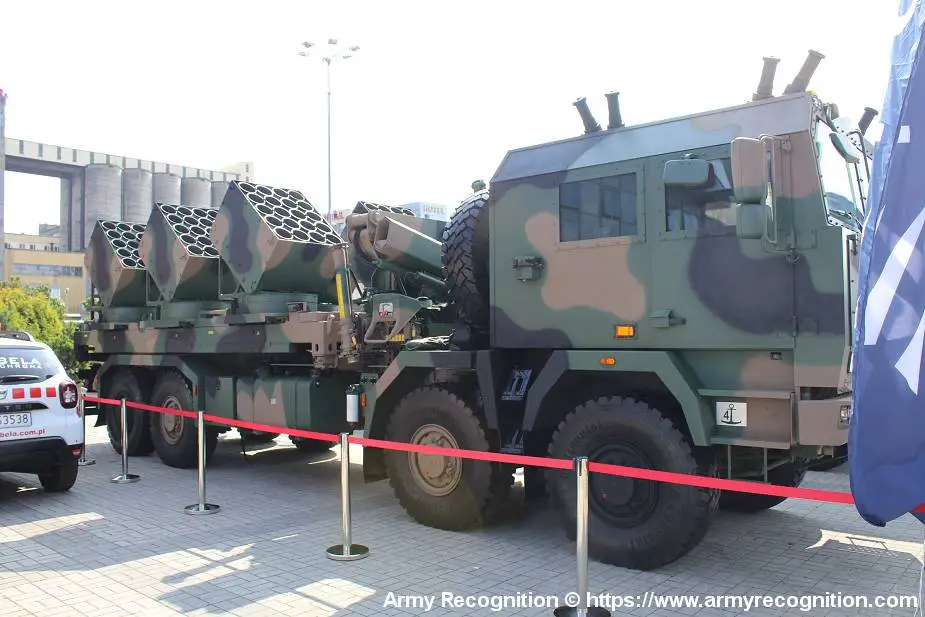Breaking news
Poland to deploy sapper battalion with Baobab-K minelaying vehicles near Belarus border.
According to an article published by The First News on July 23, 2023, Polish Defense Minister Mariusz Blaszczak announced plans to establish a sapper battalion in Augustow, northeastern Poland, later this year, with the objective of bolstering security on NATO's eastern flank and ensuring the stability of the Suwalki Gap, a strategically significant area near Belarus border. The battalion's equipment might include Baobab-K minelaying vehicles.
Follow Army Recognition on Google News at this link

The Polish BAOBAB-K truck-mounted scatterable mine-laying system (Picture source Army Recognition)
The Suwalki Gap, a sparsely populated region located between Poland's border with Lithuania, has become a matter of concern for NATO's defense due to its vulnerability. It represents a strategic point where an attack could potentially disrupt access to the Baltic States, making it a significant focus for NATO's security considerations in the event of a conflict between Russia and the alliance.
The situation between Poland, Belarus, and Russia remains tense, with reports of escalating military maneuvers and diplomatic tensions. Poland's recent decision to relocate military units closer to the Belarusian border in response to the presence of Wagner mercenary fighters, a Russian ally, prompted a response from President Vladimir Putin. In a televised Security Council meeting, Putin warned that any aggression against Belarus would be considered an attack on Russia, with potential consequences.
Concerns were raised when Andrey Kartapolov, the head of the Russian State Duma Defence Committee, issued statements about the presence of Wagner mercenaries in Belarus, leading to speculation about potential implications for the security of the Suwalki Gap. In response, Poland's establishment of a sapper battalion reflects efforts to address security concerns in the region.
The newly formed sapper battalion is set to join the 15th Gizycko Mechanised Brigade and the 16th Mechanised Division of the Polish Army. Its primary mission will focus on safeguarding the Suwalki Gap, using Polish-made scatter minelaying vehicles to strengthen defensive capabilities in the region. The Baobab-K is anticipated to be the chosen Polish-made minelaying vehicle for this important task.
The Baobab-K system originated from the initial prototype of the Baobab scattered mine laying platform introduced in September 2013. Subsequently, HSW and its collaborators were awarded a contract by the Polish army procurement agency in December 2018 to develop a specific prototype of the Baobab-K system. This collaborative effort combines the expertise of each company to create a technologically advanced and dependable mine-laying solution.
The Baobab-K system utilizes the Jelcz P662D.43 8x8 truck chassis, renowned for its mobility and durability. This chassis could also accommodate both American M142 HIMARS or South Korean Chunmoo K239 rocket launcher systems. Measuring approximately 11 meters in length, 2.6 meters in width, and 3.4 meters in height (including the launcher units), this chassis provides a stable platform for the Baobab-K system. With a combat weight of 31,700 kg, a maximum road speed of 85 km/h, and an off-road range of approximately 580 km, it enables operations in diverse terrains and conditions.
The system incorporates six mine launcher units mounted on turntables at the rear of the truck chassis. Each launcher unit, developed by Belma, has the capacity to carry up to twenty preloaded magazines manufactured by WB Group. These magazines can hold five anti-tank mines each, providing a total capacity of 100 mines per launcher unit. The Baobab-K system supports two types of anti-tank mines: the MN123.1 with immediate action and the MN123.2 with delayed action, allowing for adaptability to different operational requirements.
The MN-123 anti-tank mines are designed for effective penetration of armored vehicles. Equipped with Misznay-Schardin shaped charges on both faces, these mines have a reported penetration capability of up to 60 millimeters of armored protection at an offset of 0.3 meters. The mines are triggered by the passage of vehicles, ensuring reliable and targeted deployment in the designated area. The MN-123 mines feature an electronic magnetic influence fuze powered by a 6.8 V battery, incorporating three independent safety features to minimize accidental detonation risks. They also offer programmable self-destruct options, allowing for automatic deactivation after 2, 3, or 5 days.


























